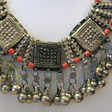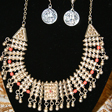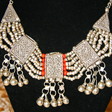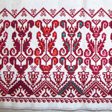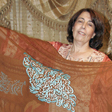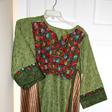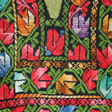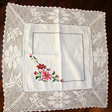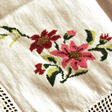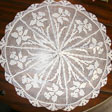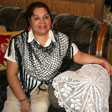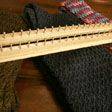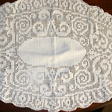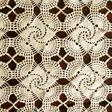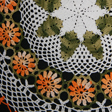Other Shreveport Articles
Cultural Preservation: Keeping the Flame Burning for Future Generations
Seasons and Cycles — Festivals and Rituals Mark Life's Rhythms
Of Hand and Heart: Handwork Connects Family and Community

Palestinian and Mexican Handwork Traditions in Shreveport
By Laura Marcus Green
The Art of Embellishment: Sultaneh Fasho
Sultaneh Fasho grew up in Amman, Jordan, where as a little girl she learned to do cross stitch embroidery from her mother and in school. "They teach us how to do these things," she explains. Sultaneh's parents immigrated from their home in Ramleh, Palestine to Amman, Jordan in 1948. They say that necessity is the mother of invention. For Sultaneh Fasho, the unsuccessful quest for the right jewelry to go with a party dress led her to try her hand at making her own necklace for a special occasion. Sultaneh explains that when Arab women don their embroidered dresses they enjoy wearing traditional necklaces that match their outfits. When she wore her own handmade jewelry, her friends admired her work, encouraging her to continue. Over the past fifteen years, she has been making jewelry from beads of silver, glass, and semi-precious stones.
Sultaneh has a degree in banking and marketing from Jordan University. She worked in banking for fifteen years in Amman before coming to the U.S., after marrying her husband. Sultaneh met her husband, who is also Palestinian, while visiting her sister in Houston, Texas. The couple married in Palestine in 2003, and then made their home in Shreveport, where he had been living.
When Sultaneh married, her friend Siham made her a cross-stitched table runner for her new home. Sultaneh liked the piece so much, she commissioned Siham to make matching napkins. Like Sultaneh, Siham is a Palestinian who immigrated to Jordan. Not only does Siham do exquisite cross stitch, she directs the Palestinian Center, an organization that teaches women to do traditional embroidery and markets their work. With some of their proceeds, the volunteer-run center helps provide educational scholarships. While still living in Jordan, Sultaneh donated her banking skills to the organization and solicited donations from bankers and others. There are a number of such organizations that are helping Palestinian women weather challenging personal, economic, and/or political times while perpetuating an important cultural tradition. In fact worldwide, traditional handwork provides a livelihood for women through artisans' cooperatives and aid organizations.
When she first started making traditional Arab style jewelry, Sultaneh taught herself the basic steps. After moving to the United States, she took several beadwork classes, through which she enhanced her techniques. The classes also inspired her to branch out into more contemporary Western styles. Sultaneh orders basic silver beads and findings online, but buys stone and traditional silver beads during visits back to Jordan.
Having mastered various jewelry-making techniques, Sultaneh now teaches beadwork and crochet classes at Hobby Lobby in Shreveport. She sells her work at two local art fairs, Shop Till You Drop in Bossier City and the Greek and More Cultural Festival at St. George Greek Orthodox Church in Shreveport, where she is a congregant. Several businesses also carry her work. Perhaps the most rewarding benefit from her jewelry work is an intangible one. Sultaneh says that making jewelry helps her "stress less." She observes, "When you are making jewelry you cannot focus on your problems because you have to focus on your work."
Mexican Handwork Artist of Multiple Traditions: Socorro Flores
Cross stitch embroidery is a valued tradition in many cultures. In spite of its simple, standard form, through variations in color and design cross stitch appears in a remarkable range of cultural styles. In Mexico, colorful and elaborate floral patterns stitched in punto de cruz (cross stitch) grace the yokes of women's traditional blouses and dresses, as well as table linens and other household items. Cross stitch was among the handwork traditions that Socorro Flores learned as she was growing up in Guadalajara in the state of Jalisco, Mexico.
Socorro and her husband left Mexico to find better employment options and safety from the drug violence that is ravaging their home country. Landing first in California, the Flores' sought a quieter lifestyle in northwestern Louisiana. Socorro has other family members living in the U.S., with sisters in Dallas, California, and Wisconsin. Her other sister, brothers, and parents still live in Mexico. As a newcomer to the area, Socorro has been making friends through her church, St. Mary of the Pines Catholic Church, where the congregation is multicultural. Socorro reports that in addition to other Mexicans, at St. Mary's she has met people from Colombia, Guatemala, Argentina, Puerto Rico, the Dominican Republic, and Uruguay. There are also church members hailing from the Philippines, Vietnam, and India.
Socorro remembers learning to do handwork when she was about nine years old, during a vacation. The first thing she made was a colcha, or bedcover, that she crocheted with fine cotton yarn. She started out with a challenging project! She recalls her pride upon finishing that first piece: "It was really hard, but I did it!" She continues to make household linens like tablecloths and doilies from cotton yarn, using intricate designs, as well as apparel like yarn shawls and scarves. Socorro does not use a pattern when doing her fine crochet work. She simply looks at a piece she likes and copies it by sight.
In addition to crochet and cross stitch, Socorro knits and uses a tool called a tablita ("board"), to make all manner of scarves, shawls, and afghans. Socorro's mother brought her the tablita from Mexico. With this simple tool—a board with a slit in the middle and small metal rods extending from the top—she creates beautiful accessories for herself and others.
Socorro says that when she was growing up, it was important for girls to learn how to do handwork. Today, she finds in the different techniques she knows an enjoyable and practical activity. Socorro believes that it is still beneficial for girls to learn these art forms. Knowing their importance to her culture and their potential to provide young people with a positive and rewarding skill, she is willing to teach youth in her community.


